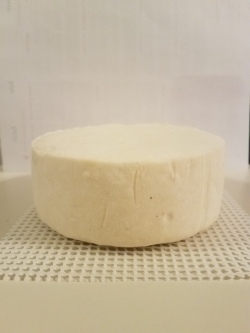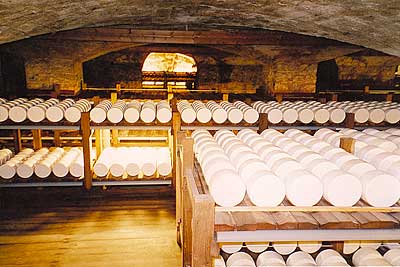
When it comes to making cheese, the making portion – heating the milk, adding the starter culture and rennet, cutting the curd, etc. is only part of the process. If you’re making a hard cheese, then once it comes out of the press, all you have is a block of curd, which is edible, but rather flavorless. In order to turn that block of curd into cheese, you have to age it. Aging is what gives cheese its flavor and character. When you age cheese, you set that block of curd in an environment that will allow the bacteria in to roam throughout that curd block chewing up lactose and other material and expelling waste products. It is these waste products (a.k.a. bacterial poop) that makes cheese look and taste so good.
But what exactly is this “environment” of which I speak? Simply put, cheese must be set in a place where the temperature is 46-60oF and the relative humidity is 75-90%. If it’s too cold, the cheese won’t develop the proper level of acid and flavor. Too warm, and the cheese will develop a sharp and pungent flavor and/or undesirable microbial growth.
So how do you create this environment? There are several ways.
Caves – In Europe, where they have been making cheese for centuries, there exist various caves where the conditions are just right for aging cheese. Here is the United States, cheesemakers will build warehouses where they can artificially create the proper conditions. But since most of you who are reading this probably do not own or have access to a cave or have the time, money, and materials to build your own warehouse, there are other ways of creating the proper aging conditions
Basements – Many home basements, since they are below ground, are often much cooler than the house and land above ground. Temperatures in most home basements are usually right in that 46-60oF range. Moisture levels can be increased by hanging wet towels or using a portable humidifier.
Wine coolers – Wine coolers are ideal for aging cheese, because they have controls for both temperature and humidity.
Small, dorm-sized refrigerators – These work well for aging cheese, however, the built in temperature control dial is often not very precise. Turn it a notch one way or another, and the temperature is either too high or too low. You may have to purchase and hook in a thermostat that allows you to control temperature with more precision. Humidity can be maintained by setting a bowl of water on the bottom shelf and/or placing wet paper towels at the bottom.
Though the aging requirements for cheese are precise, they are not impossible to attain. With the proper equipment and locale, be it basement, wine cooler, or dorm-sized refrigerator, you too can age cheese in your very own home. A homemade Cheddar, Swiss, or Manchego can be a reality!


